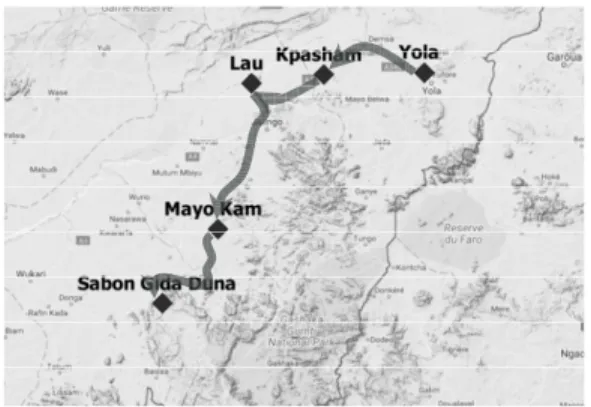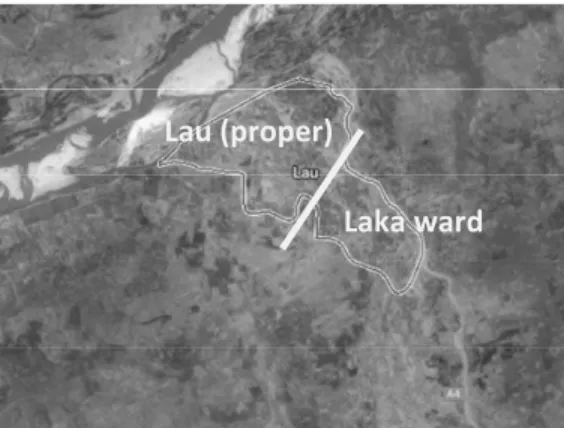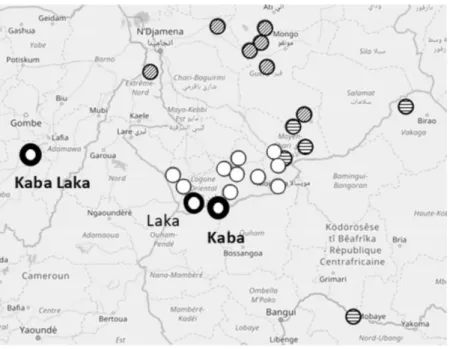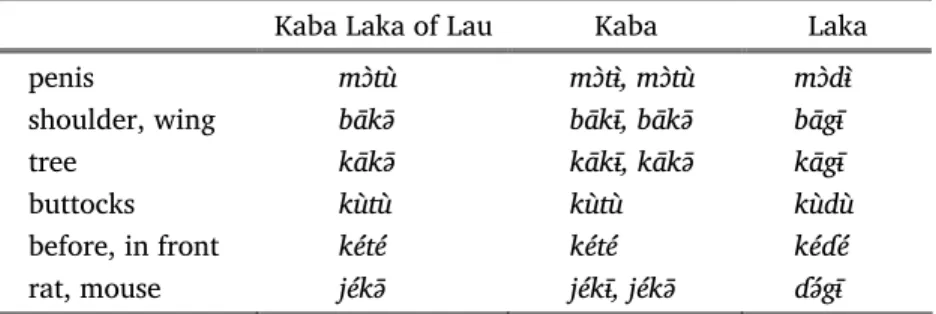HAL Id: halshs-03044510
https://halshs.archives-ouvertes.fr/halshs-03044510
Submitted on 14 Dec 2020HAL is a multi-disciplinary open access archive for the deposit and dissemination of sci-entific research documents, whether they are pub-lished or not. The documents may come from teaching and research institutions in France or abroad, or from public or private research centers.
L’archive ouverte pluridisciplinaire HAL, est destinée au dépôt et à la diffusion de documents scientifiques de niveau recherche, publiés ou non, émanant des établissements d’enseignement et de recherche français ou étrangers, des laboratoires publics ou privés.
Nigeria as a linguistic terra incognita: The two
languages of Lau
Dmitry Idiatov, Mark van de Velde
To cite this version:
Dmitry Idiatov, Mark van de Velde. Nigeria as a linguistic terra incognita: The two languages of Lau. Andrey A. Kibrik; Kseniya P. Semenova; Dmitry V. Sichinava; Sergey G. Tatevosov; Anna Yu. Urmanchieva. ������� �����������: ����������� ���������� [VAProsy jazykoznanija: A megacollection of nanopapers], Buki Vedi, pp.322-328, 2020. �halshs-03044510�
The two languages of Lau
*
Dmitry Idiatov, Mark L. O. Van de Velde
LLACAN (CNRS — INALCO)
dmitry.idiatov@cnrs.fr; mark.vandevelde@cnrs.fr
1. Introduction
Linguistically, Nigeria is both the third richest and second least studied country in the world. In addition to the four major languages spoken by mil-lions of speakers — Yoruba, Hausa, Igbo and Nigerian Pidgin — hundreds of other languages of varying sizes are spoken there. The Ethnologue (https://www.ethnologue.com/country/NG) lists 517 languages. In reality, no one knows the exact number. These languages can be grouped into an equally unknown number of language families, most of which belong in one way or another to the Niger-Congo macro-family, with the exception of the Chadic and Ijoid languages, Kanuri and a few presumed isolates. According to a recent bibliometric study (Harald Hammarström, p.c.), we currently have a gram-matical study for only 17% of Nigerian languages, compared to an average of 30% in Africa and 31% worldwide. In addition, there are several language families for which no grammatical studies have been published, such as the Wurbo or Jarawan groups.
The wider Benue River Valley in the northeast of Nigeria is one of the ar-eas with the highest concentration of languages on which very little linguistic research has been done so far. AdaGram (http://llacan.vjf.cnrs.fr/AdaGram/ index.html) is a recent research project aimed at improving our knowledge of the languages of this region. One of the first research initiatives of the Ada-Gram project was a linguistic survey in 2016 (see Idiatov et al. 2017 for more
* This research is produced within the AdaGram project (http://llacan.vjf.cnrs.fr/AdaGram/ index.html) funded by the “Emergence(s)” program of the City of Paris. We also gratefully acknowledge the support of the project GL7 “Reconstruction, genealogy, typology and grammatical description in the world’s two biggest phyla: Niger-Congo and Austrone-sian” of the Labex EFL supported by a public grant overseen by the French National Research Agency (ANR) as part of the program “Investissements d’Avenir” (reference: ANR-10-LABX-0083). It contributes to the IdEx Université de Paris — ANR-18-IDEX-0001.
Dmitry Idiatov, Mark L. O. Van de Velde. Nigeria as a linguistic terra incognita 323 details). The general goal of this survey was to gather basic lexical and gram-matical data for a number of languages of the region about which almost noth-ing is known. Another goal was to establish contacts with these lnoth-inguistic communities to prepare ground for prospective PhD candidates who would undertake comprehensive grammatical and lexical descriptions of these lan-guages for their PhD. Figure 1 shows the itinerary of the survey with Yola as its starting point and the four settlements visited, Kpasham, Lau, Mayo Kam and Sabon Gida Duna.
Figure 1. The itinerary of the 2016 AdaGram survey
2. Lau: One town, two absolutely unrelated languages
The most spectacular discovery of the survey was made in Lau. According to the existing linguistic atlases, such as Blench 2019 and Eberhard et al. (eds.) 2020, the language spoken in Lau is called Laka [ISO 639-3: lak] and belongs to the Mbumic family of the Adamawa pool1 within the Niger-Congo
macro-family, as illustrated on Figure 2. This classification is not based on linguistic data, as none was available before the AdaGram survey. It is based purely on the name of the language, as the term Laka has sometimes been used in the literature to refer to the Mbumic languages (see references in Elders 2006: 45– 46), and the fact that many languages in that part of the Benue River Valley are traditionally referred to as Adamawa languages, with Mbumic being an Adamawa group.
1 Adamawa is best seen as a referential label for a number of currently unclassified
low-level Niger-Congo language groups spoken in a region stretching from the Benue valley in Eastern Nigeria to the Guéra and Moyen Chari administrative regions in Southern Chad.
Figure 2. The Mbumic languages and Laka
(adapted from Glottolog.org; accessed on 20.08.2017)
However, our survey established that the town of Lau is divided between two distinct linguistic communities who speak mutually unintelligible lan-guages. The map in Figure 3 shows the town of Lau and its approximate divi-sion into two parts, Lau proper in the northwest closer to the Benue River and the Laka ward of Lau (Hausa Angawan Lakawa, formerly known as Garin
Lakawa ‘Laka town’).
Lau (proper)
Laka ward
Dmitry Idiatov, Mark L. O. Van de Velde. Nigeria as a linguistic terra incognita 325 The subsequent analysis of the data made it clear that neither of the two languages is Mbumic. One language, which can be referred to as Lau [làw],2
is a variety of Shoo-Minda-Nye [bcv; shoo1247], which belongs to the Wurbo group of the Jukunoid languages. The other language, which we refer to as Kaba Laka [kābá làkà], turned out to be the only Central Sudanic language of Nigeria. More specifically, Kaba Laka belongs to the Sara-Bongo-Bagirmi branch of Central Sudanic and is a variety of the Central Saraic language Kaba [ISO 639-3: ksp; glottocode: kab1281], which is otherwise spoken more than 500 km to the southeast in the extreme southwest of Chad and across the bor-der in the northwest of the Central African Republic. Figure 4 shows the dis-tribution of the Central Saraic languages, the location of Kaba Laka of Lau and Kaba, as well as their closest relative Laka.
Figure 4. Kaba Laka and the other Saraic languages.
The Central Saraic languages are marked with white circles. The map also shows the primary location of Kaba [ksp; kab1281]
and of its closest relative Laka [lap; lak1254]
2 The name of the town Lau [làw] means ‘mud’. The speakers of Lau refer to their own
language simply as the language of the people of Lau [w̃ĩ̄ lâw mã̄] (people Lau lan-guage).
Table 1 shows a selection of words from the two languages spoken in Lau, namely Kaba Laka and Lau, as well as their translations in Kaba and Laka spo-ken in Chad.
Kaba Laka
(Nigeria) Kaba and Laka (Chad) Lau
animal dā(ː) dā nɛ̃́wkũ̂
cow mã̀ŋgə̄ mã̀ngɨ̄ nâw
chicken kũ̄nʤá kũ̄nʤá zǟw
man ʤĩ̀ŋgàw ʤĩ̀ŋgàw jĩ̂nə̀nwò
medicine kũ̀mã̄ ~ kùmā kũ̀mã̄ ~ kùmā gâj Table 1. A selection of words from Kaba Laka and Lau
spoken in Lau (Nigeria) and their equivalents in Kaba and Laka spoken in Chad (cf. Keegan 2014)3 3. Kaba Laka is a variety of Kaba [ksp; kab1281]
As can be readily observed in Table 1, Kaba Laka words are identical to their equivalents in Kaba and Laka, but radically different from those of Lau. Since Kaba and Laka are lexically very similar and the speakers of Kaba Laka use the term Laka when referring to themselves and their language in English and Hausa, initially we mistakenly identified Kaba Laka of Lau as a variety of Laka (cf. Idiatov et al. 2017). However, a closer examination of the data re-vealed that Kaba Laka of Lau is most similar to Kaba. As illustrated in Table 2, both Kaba Laka and Kaba preserve word-internal intervocalic voiceless stops, corresponding to voiced and sometimes implosive stops in Laka. In fact, the name Laka is làkà in Kaba and Kaba Laka, while in Laka itself it has the form
làgà. Furthermore, Kaba Laka shares at least one lexical item ‘rat, mouse’ with
Kaba to the exclusion of Laka.4
3 We use an IPA-based transcription here and we normalized the forms taken from other
sources accordingly. For comparative reasons, Keegan (2014) distinguishes between ɨ and ə. However, in his Kaba and Laka data both symbols represent the same neutral central vowel, for which we prefer to use the traditional schwa symbol ə, even though phonetically it is usually realized rather high as [ɘ] (but not as high as [ɨ]).
4 Despite the superficial similarity of the Laka form ɗə́gɨ̄ ‘rat, mouse’, its initial consonant
cannot be a regular correspondence of Kaba j (see Boyeldieu 2000: 241 on the com-parative series ‘rat, mouse’).
Dmitry Idiatov, Mark L. O. Van de Velde. Nigeria as a linguistic terra incognita 327
Kaba Laka of Lau Kaba Laka
penis mɔ̀tù mɔ̀tɨ̀, mɔ̀tù mɔ̀dɨ̀ shoulder, wing bākə̄ bākɨ̄, bākə̄ bāgɨ̄ tree kākə̄ kākɨ̄, kākə̄ kāgɨ̄ buttocks kùtù kùtù kùdù before, in front kété kété kéɗé rat, mouse jékə̄ jékɨ̄, jékə̄ ɗə́gɨ̄ Table 2. A comparison of Kaba Laka of Lau with Kaba
(Moser and Dingatoloum 2007, Keegan 2014) and Laka (Keegan 2014)
4. Lau is a variety of Shoo-Minda-Nye [bcv; shoo1247]
The classification of Lau as a variety of Shoo-Minda-Nye [bcv; shoo1247] is based on the claims of the speakers of Lau that they speak mutually intelli-gible languages with the inhabitants of the neighboring settlements of Kunini, Bandawa and Jeshi, whose languages are considered by Shimizu (1980a: 41–44) to belong to the Wurbo group of the Jukunoid languages. However, Shimizu (1980a) does not provide any linguistic data for the lects spoken in these set-tlements and only refers to three unpublished wordlists of 42 (Lau), 112 (Ban-dawa) and 102 (Minda) items collected around 1930 by Charles K. Meek (cf. Shimizu 1980b: xiv).5
Shimizu (1980a)’s classification of Wurbo languages as Jukunoid is plau-sible but needs to be confirmed with more data, since Shimizu has not col-lected data on these languages himself and relies heavily on the following ob-servation by Meek (1931: 35):
“The people of Lau (and the surrounding towns of Bandawa, Kwinini, Minda etc.), though located within twenty-five miles of Kona, do not speak Jukun as their mother tongue. Their language is of a primitive monosyllabic type, but the vocabulary shows a number of resemblances to Jukun, and their close association with the Jukun is evident from the number of religious cults which they share with the Jukun of Kona”.
5 Unfortunately, this kind of situation is by no means unfamiliar for Africanists.
Al-though the Dogon have fascinated researchers and the general public for decades, their languages have only recently been the object of systematic study. Thus, before Plungian’s (1995) study of Tommo So, we knew hardly anything about the biggest Dogon language.
However, Meek’s judgements need to be taken with caution as he contin-ues the above statement by adding that “[t]he same remarks apply to the riverain Jen, who like the Jukun, worship Ma” (1931: 35). Yet, we currently know that Jen languages [glottocode: jenn1241] are only very distantly re-lated to Jukunoid. Like the Mbumic languages mentioned earlier, the Jen lan-guages are one of the so-called Adamawa groups.
References
Blench R. 2019. An atlas of Nigerian languages. 4th ed. Cambridge: Kay Williamson
Educational Foundation.
Boyeldieu P. 2000. Identité tonale et filiation des langues sara-bongo-baguirmiennes
(Afrique Centrale). Cologne: Rüdiger Köppe.
Eberhard D. M., Simons G. F., Fennig C. D. (eds.). 2020. Ethnologue: Languages of the
world. 23rd ed. Dallas: SIL International. http://www.ethnologue.com/.
Elders S. 2006. Issues in comparative Kebi-Benue (Adamawa). Africana Linguistica, v. 12, 37–88.
Idiatov D., Van de Velde M. L. O., Olagunju T., Andrew B. 2017. Results of the first AdaGram survey in Adamawa and Taraba States, Nigeria. Paper presented at the
47th Colloquim on African Languages and Linguistics (CALL), Leiden, Netherlands.
http://llacan.vjf.cnrs.fr/AdaGram/talks/2017_CALL_AdaGram_ Survey_Results.pdf. Keegan J. M. 2014. The Western Sara languages. 5th ed. Cuenca: Morkeg Books.
http://morkegbooks.com/Services/World/Languages/SaraBagirmi/pdfs/TheWeste rnSaraLanguages.pdf.
Meek C. K. 1931. A Sudanese kingdom. An ethnographical study of the Jukun-speaking
peoples of Nigeria. London: Kegan Paul, Trench, Trubner & Co.
Moser R., Dingatoloum J.-P. 2007. Kabba-English-French Dictionary. München: LINCOM Europa.
Plungian V. A. 1995. Dogon. München: LINCOM Europa. Shimizu K. 1980a. Comparative Jukunoid. V. 1. Wien: Afro-Pub. Shimizu K. 1980b. Comparative Jukunoid. V. 2. Wien: Afro-Pub.



